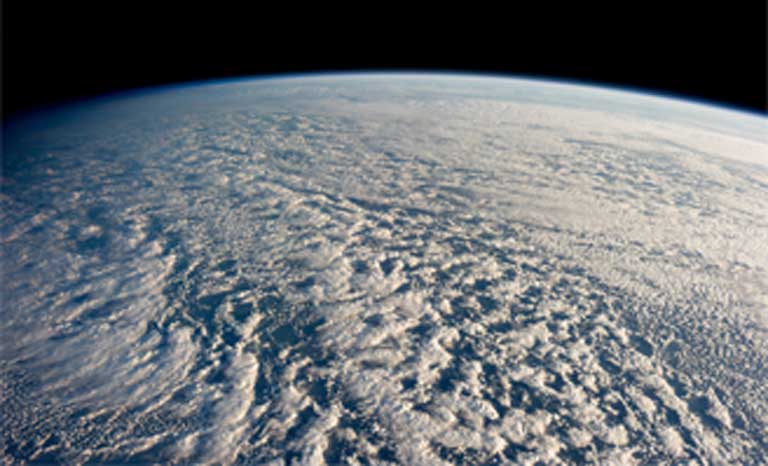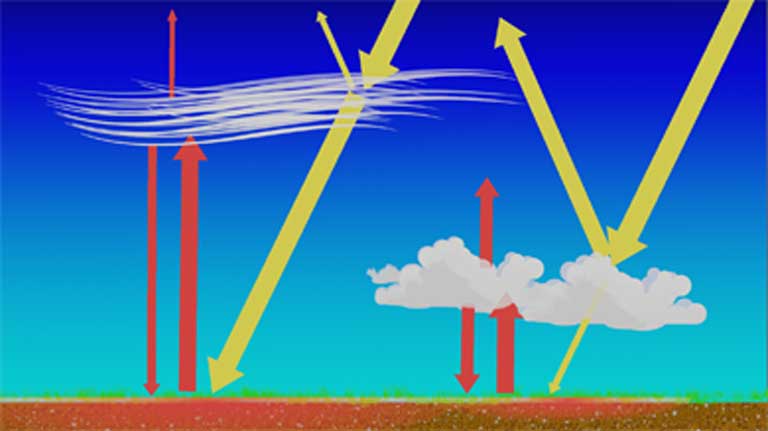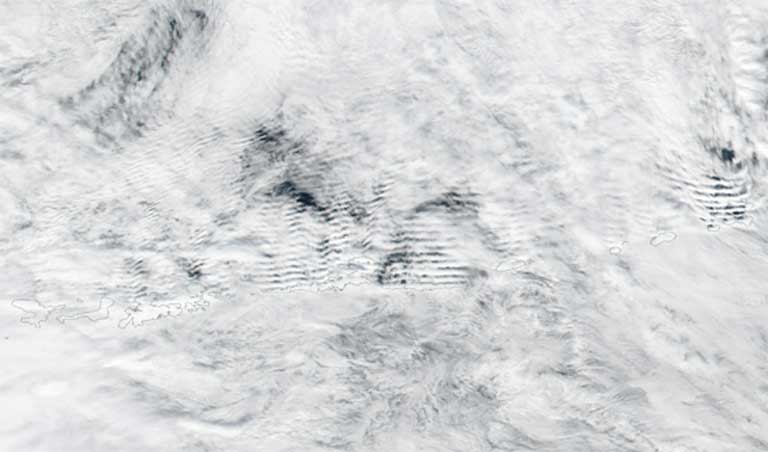- Best estimates for global temperature increases due to a doubling of atmospheric CO2 since the start of the industrial era are between +1.5C and +4.5C. A major reason for this huge range of uncertainty is how clouds will perform in a warmed world, with some modelers saying clouds will help cool the planet, while the majority say clouds will further warm it.
- Clouds add immense uncertainty to climate models because they contain so many variables (including altitude, size, turbulence, amount of ice crystals, quantity and particle chemistry), and also because they don’t fit neatly inside the global grid cell system that modelers use to estimate warming.
- A new study used a machine learning model to bypass previous cloud modeling problems. The researchers concluded that a doubling of atmospheric CO2 will most likely lead to a 3.2C (5.76F) global temperature increase, almost exactly in the middle of the range estimated by the majority of current U.N. Intergovernmental Panel on Climate Change models.
- Researchers within and outside the study agree more data and research is needed to confirm or alter these results.
Most of us think of them as puffy and picturesque, but for climate modelers, clouds are a major thorn in the side, and are the hard question. Scientists do know clouds wield an outsize influence on climate: Reducing Earth’s cloud cover by just 5% would have the same planet-wide warming effect as all the CO2 released into the atmosphere since the start of the industrial age.
The big problem, however, is that as the earth warms, the effect of clouds changes too, and after decades of research and debate scientists can’t agree exactly how. Most think clouds will warm the earth overall, others think they could cool it, and no one is sure by how much either way.
Not knowing how these potentially huge cloud influences will unfold makes predicting climate change very difficult. The best estimate of temperature increase due to a doubling of atmospheric CO2 lies anywhere between +1.5C (2.7F) and +4.5C (8.1F), according to the U.N. Intergovernmental Panel on Climate Change (IPCC). Most of that gigantic uncertainty owes to the difficulty of modeling clouds.

Now that uncertainty range may have been narrowed down to a sliver, based on the findings of a new study by researchers at Imperial College, London. The team took a novel approach, sidestepping finicky cloud modeling schemes altogether, and turning to machine learning to predict climate “cloud feedback” instead.
Climate models work by slicing the world up into a three-dimensional grid and assigning values such as humidity, temperature, air pressure and a host of other descriptors within each entire cell. But clouds are wispy, ephemeral and driven by microscopic processes. “You can’t model the physics of clouds themselves,” says Paulo Ceppi, co-author of the new study. “If you think about a cloud, if you really wanted to simulate a cloud, you would need to simulate every individual droplet and ice crystal.”

Clouds are also typically much smaller than the size of a single grid cell (with each cell usually covering 100km2, or 62 sq. mi.), making it hard to know where they fit into the model. And that is a huge problem, because where clouds are determines whether they cool or warm the earth.
Lower level clouds tend to reflect sunlight back out into space, having a cooling effect; higher level clouds can act as a blanket, trapping heat and warming the earth. At higher latitudes, where there is less sunlight to reflect, that blanketing effect currently dominates, all other factors being equal. Scientists think that clouds presently cool the earth more than they warm, but if low-level clouds decline or move further northward as global warming escalates, that could change.


Traditionally, the cloud modeling problem has been addressed through “parameterization,” algorithms that predict the probability or percentage of cloudiness in a grid cell. Initially, these algorithms were crude, sometimes just a binary choice between cloudy and not-cloudy depending on a cell’s relative humidity. Today’s algorithms are dense, knotty blocks of Fortran code, accounting for altitude, size, turbulence, amount of ice crystals, quantity and even chemistry of particles in the air.
Despite this added detail, or perhaps because of it, different parameterization schemes give wildly different results. Understanding why, says Ceppi, is difficult. Cloud models “are so complicated, and they have grown [more so] over generations of coders. People know what’s in there, but as soon as the model isn’t super simple, it becomes quite hard to describe what’s happening.”
Each cell “becomes a complex system, just like the real world,” says Peer Nowack, co-author of the new study.
Ceppi and Nowack took a different, simpler approach. Instead of trying to simulate the real world in ever finer detail, they looked at it from the top down. Reasoning that cloudiness at any given point statistically correlates to just a handful of key climate factors, chief among them surface temperature, they used a machine learning model to scan 20 years of climate data (from March 2000 to September 2019) — augmented by modeled estimates to fill in any gaps and seeking a formula that best defines the relationship of cloud changes to warming.

This wasn’t the first attempt to apply statistical analysis to clouds, but previous studies had focused only on certain types of clouds, or regions of the earth. The new study, by contrast, analyzed the entire planet, at every altitude. Moreover, instead of analyzing each point in isolation, the research team correlated the cloudiness at each point to a large area surrounding it, allowing the researchers to account for spatial patterns in cloud-forming factors.
Once the formulas had been derived, predictions could be made as to what might happen to clouds as global temperatures rise. The researchers then compared the predictions against the climate models used by the IPCC in drafting its assessment reports. Their results showed that the majority of climate modelers have it about right: global warming will result in a decline in low-level clouds and a rise in the altitude of high level clouds, implying a positive cloud feedback, meaning clouds will add to warming over time.
The results, says Ceppi, were “bang on” with the average effect seen in models.
“We find robust evidence that clouds amplify warming. Our results don’t shift the central [temperature increase] estimate one way or another… It’s not that things are worse than we previously thought. It’s that we’re more confident that it will be what we thought it would be [according to our current models].”
The researchers conclude that a doubling of atmospheric CO2 will most likely lead to a 3.2C (5.76F) global temperature increase, almost exactly in the middle of the IPCC’s estimate range. A temperature increase of less than 2C (3.6F) — the maximum increase to avoid climate disaster — has only a 0.5% probability, say the researchers.

“It’s an interesting study,” says Annica Ekman, a climate modeler at Stockholm University who was not involved in the research. She sees an important innovation in the use of spatial correlation. “That’s clever. I think we need that. I think this could be why previous parameterizations, when it was parameterizations… did not work so well, for low-level clouds, because they might not have had this large-scale influence in them.”
But machine learning is only as good as the data it is trained on, and is insufficient to make such a definitive conclusion in this case, says Kevin Trenberth, a Distinguished Scholar at the U.S. National Center for Atmospheric Research. “The data used [in the new study] are not real data, but come from models and are known to contain flaws,” he wrote in an email. Trenberth points out that the period under study was dominated by an unusually strong El Niño. “They would need another 50 years of data in order to sample a dozen El Nino events,” and confirm their results.
The study researchers maintain that they did account for data anomalies in their own uncertainty estimates, but admit more data would have been preferable.
Ceppi, however, anticipates a deeper concern. “The one limitation of our approach… would be if all the [cloud] models [used by the new study] happen to be wrong. And things are so non-linear, in a way that is not captured by any of the models. Then we fail.” But that will happen, he says, only at the highest levels of global warming.
“Then we’re talking about tipping points,” says Nowack. Then we’ve got bigger problems.
Conrad Fox is a freelance journalist and media producer. Find his work at conradfox.com and follow him on twitter @willybones.
Banner image: Low lying clouds fill valleys in the Andes Mountains of Peru. Thin wispy clouds like these are very hard to model, but can have strong impacts on the climate. Image by Diego Delso.
FEEDBACK: Use this form to send a message to the author of this post. If you want to post a public comment, you can do that at the bottom of the page.

